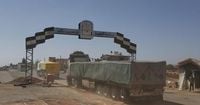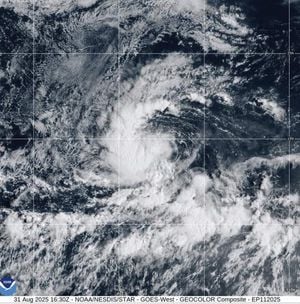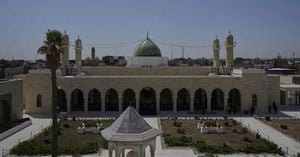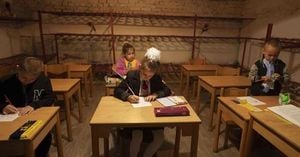After weeks of mounting tension and hardship, hope finally arrived in the city of Sweida, southern Syria, on Thursday, August 28, 2025. For the first time since mid-July’s deadly sectarian clashes, an aid convoy rolled directly into the city via the main highway from Damascus, marking a critical moment in the region’s struggle to recover from both violence and years of civil war.
The convoy’s arrival, widely reported by outlets such as AP and SANA, was more than just a logistical feat—it symbolized a lifeline for thousands of residents who have endured siege-like conditions since violence erupted between government forces and local Bedouin tribesmen on one side, and fighters from the Druze minority on the other. The fighting, which broke out in mid-July, left hundreds dead and displaced tens of thousands, according to the Associated Press. Reports and allegations have surfaced, including claims of government fighters executing Druze civilians and looting and burning houses, further deepening the trauma for the city’s inhabitants.
Although the fighting has largely calmed, the aftermath has been grim. Government forces have surrounded Sweida, and the Druze community has repeatedly described the situation as a siege, with little aid making its way in. Until Thursday, the main highway—the city’s vital artery—remained closed, forcing the few aid convoys that did reach Sweida to take a much longer, circuitous route through Daraa province, south of Sweida. This detour added days to delivery times and limited the amount of help that could arrive.
But Thursday’s breakthrough brought a convoy of 18 trucks carrying desperately needed supplies. State-run Al-Ikhbariya TV detailed that the shipment included food baskets, cleaning supplies, and solar-powered lamps. Omar Al-Maliki, an official at the Syrian Arab Red Crescent, told SANA that the convoy also carried medical and health supplies, malnutrition treatment supplies, diesel, water pipes, and accessories. The lamps were earmarked for the Health Directorate, Water Authority, and local civil society organizations, aiming to restore a semblance of normalcy amid ongoing hardship.
The aid was provided with support from the World Food Program, UNICEF, and the United Nations Population Fund, as confirmed by SANA. This collaboration underscores the scale of the crisis and the international community’s recognition of Sweida’s urgent needs. Despite being the twenty-first aid convoy sent to the southern region, this was the first to enter via the main highway since the outbreak of violence, highlighting the significance of the event.
The convoy’s arrival could not have come at a more critical time. U.N. Humanitarian Coordinator for Syria, Adam Abdelmoula, visited Sweida last week and painted a dire picture of the city’s health system. In his statement, Abdelmoula warned that hospitals and clinics were “under severe strain,” facing “acute shortages of essential medications, including insulin, dialysis supplies, and cancer treatments.” The shortages have forced families to wait in long lines for fuel and other essentials, while prices for basic goods have soared, putting even more pressure on households already battered by conflict and economic instability.
“Humanitarian assistance alone cannot resolve these challenges,” Abdelmoula emphasized. “Restoring safe and reliable flows of commercial goods is critical to stabilizing the situation and preventing further deterioration.” His words echo the sentiments of many aid organizations and local leaders, who argue that while the arrival of food, medicine, and supplies is vital, it is only a temporary fix. Without a broader restoration of commerce and infrastructure, Sweida’s recovery remains precarious.
The underlying causes of the July violence are complex and deeply rooted in Syria’s long and bloody civil war, which has dragged on for nearly 14 years. The conflict in Sweida is just one chapter in a national saga marked by shifting alliances, sectarian tensions, and the constant struggle for control over territory and resources. The city itself, predominantly Druze, has often found itself caught between government forces and various opposition groups, and the recent violence only amplified the community’s sense of vulnerability.
Allegations that government fighters executed Druze civilians and engaged in looting and arson have fueled anger and mistrust, complicating efforts to broker peace and deliver aid. While the government has described its actions as necessary to restore order, many Druze leaders and residents see the siege and the slow trickle of aid as collective punishment—a tactic to pressure the community into submission.
The reopening of the highway and the arrival of the convoy have offered a glimmer of hope, but challenges remain. The city’s infrastructure is battered, and the health system, as described by Abdelmoula, is on the brink. Essential medications like insulin and cancer treatments are in critically short supply, and malnutrition is a growing threat, especially among children and the elderly. The inclusion of malnutrition treatment supplies in the latest convoy is a direct response to these fears, but aid workers warn that much more is needed.
On the economic front, the blockade and ongoing insecurity have sent prices for basic goods skyrocketing. Families line up for hours, sometimes days, to obtain fuel, bread, or clean water. The aid convoy’s delivery of diesel and water pipes aims to address some of these shortages, but as Abdelmoula and others have pointed out, these are stopgap measures. For Sweida to truly recover, the flow of commercial goods—everything from food and fuel to building materials and medicines—must be restored and stabilized.
The international community, led by organizations like the World Food Program and UNICEF, continues to call for safe, unimpeded access to all parts of Syria. Yet, as recent events in Sweida have shown, humanitarian efforts are often stymied by political and military realities on the ground. The reopening of the main highway is a step forward, but it remains to be seen whether it will stay open and whether more aid convoys will follow.
For now, the people of Sweida are left to navigate an uncertain future. The arrival of the convoy has brought some relief, but the scars of violence and siege linger. As one local official put it, the city must not only rebuild its homes and hospitals but also its sense of security and trust. The world will be watching to see whether this latest aid delivery marks the beginning of a real recovery, or just a brief respite in a long and difficult journey.





